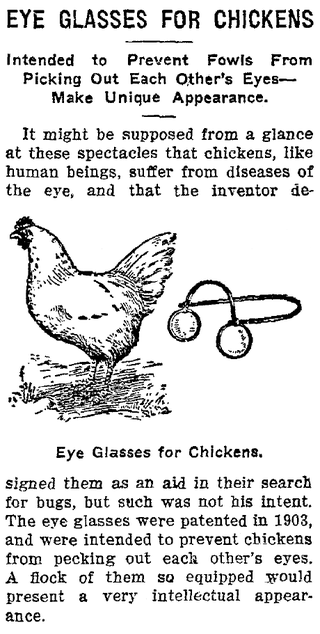 Back in 1903, Andrew Jackson, Jr. from Munich, Tennesee, patented an "Eye-protector for chickens". They were sold by mail order from the Sears-Roebuck store or through chicken feed stores.
Back in 1903, Andrew Jackson, Jr. from Munich, Tennesee, patented an "Eye-protector for chickens". They were sold by mail order from the Sears-Roebuck store or through chicken feed stores.
Chicken eyeglasses were often made from celluloid or aluminum and typically consisted of "two oval panels that fit over the upper beak of the chicken. A pin is put through the nostril to-hold the oval pieces in place." Different designs were produced that attached to the chicken's head in different ways. Some were held in place by a strap, some by small hooks into the nares (nostrils) and some by piercing the bone septum between the nostrils with a cotter pin.
Some versions of the devices had lenses that were semi- or fully transparent whereas others were tinted, often red- or rose-colored. Other designs were blinders which are opaque and completely prevent forward vision. The intended purposes of chicken eyeglasses were to prevent aggressive pecking, cannibalism and feather pecking.
Red-tinted lenses were considered to be effective in reducing internecine pecking because they disguise the color of blood.] As summed up in a 1953 article in Indiana's National Road Traveler newspaper, "The deep rose-colored plastic lenses make it impossible for the cannibal [chicken] to see blood on the other chickens, although permitting it to see the grain on the ground."
Elmer Haas of the National Band & Tag Company, a major producer of rose-colored chicken eyeglasses, whose grandfather had "devised wire frames for chickens in 1902", indicated that he believed the purported blood-masking effect of the rose coloring was a myth: "the firm added the rose colored glasses because it indulged the chicken owners ... [c]hickens are color blind". (In fact, chickens, like other birds, have good color vision.) The firm had added the rose-colored feature to its glasses in 1939 under the brand name "Anti-Pix". This variety of eyeglasses was more complicated than others because the red lenses were fixed to a hinge at the top of the frame. This meant that as the hen lowered its head to feed, the lens swung out giving the hen an unobstructed view of the ground. When the hen raised her head, as she would during aggression, the lens would swing down giving the hen a red tinted perception of the environment.
Rose-colored contact lenses, rather than eyeglasses, have also been proposed to reduce cannibalism in chickens.
Though their use was not common, they were used still on 1973, as reported by Illinois' "The Hawk-Eye" newspaper, in which a farmer had 8,000 chickens fitted with a rose-colored variety.
Source: Wikipedia.
Editor note: Now, after reading this, I'm questioning myself if "HawkEye" is still a good nickname ![]()